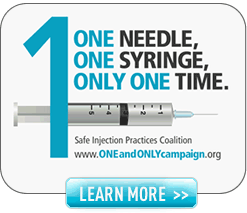Our guest blogger this week is Chuck Griffis, CRNA. Chuck is a certified registered nurse anesthetist and travels the country lecturing on infection control and safe injection practices for the AANA Practice Committee. We thank him for joining his efforts with AANA and HONOReform in working to stop drug diversion and prevent patient infection.
I work in the OR as a clinical nurse anesthetist 2-4 times a month in addition to serving on my state and national nurse anesthetist organizations, and conducting research in chronic pain. One of my roles is to serve as infection control liaison to the Practice Committee of the AANA—so I understand infection control and clinical setting challenges.
Infection control meets drug diversion in one particular setting: where anesthesia providers have drawn up controlled substances with which to sedate patients. Folks who don’t do clinical work will often ask—how could these drugs and sterile syringes wind up being stolen or swapped for contaminated devices containing saline? Aren’t all providers supposed to keep all controlled substances under immediate visual and personal control at all times? How could this happen? Allow me to explain how the real clinical world works.
Patients arrive frightened and anxious and often in pain and there are always cases waiting to follow, with tremendous production and time pressure. So the anesthetist must quickly draw up the correct controlled drugs, label them and store them somewhere for use. Though we are urged to keep the drugs in our pockets, they cannot stay there. The drugs have to be placed on the anesthesia cart or machine shelf because they must be immediately accessible for multiple administrations—keeping them in a pocket makes it difficult to identify correct syringes among the many when in a hurry, and is a hazard for contamination as pocket surfaces loosen the sterile caps.
Once the drugs have been placed in the anesthesia work environment, the anesthesia provider is often involved with the patient—holding, comforting, positioning, straightening lines, holding masks and airways open, cycling monitors, checking cables, moving the bed up and down or rotating it. The environment is often darkened during cases involving endoscopes of any sort. There are multiple people present: techs, nurses, drug and equipment representatives, residents, students, physicians. As the anesthetist reaches under the drapes to re-attach a monitor or check on breathing, it is easy for one of these people, often in close proximity, to switch out the patient’s syringe for an already-contaminated syringe of saline identical to the last 25 syringes used in that room, that day. Perhaps the machine shelf is bumped “accidentally”, causing syringes to fall on the floor and the “helpful” tech picks up the syringes for the busy anesthetist who may be involved in a life-threatening situation and unable to devote any attention to a potential diversion.
There is no system that uniformly investigates the background of the various people in that room with the anesthetist. Often no one knows every person who is present personally, or at all, especially in large institutions, where huge numbers of personnel rotate through every OR and procedure area. There is no one person to monitor the actions of everyone in that procedure. Everyone is focused on their extremely complex and demanding portion of the intervention, often leaving no attentional reserve for potential diversion. Anyone of those people could have various previously-stolen used syringes in their pockets, now filled with saline, looking for an opportunity to swap syringes.
I hope this helps everyone understand how drug diversion can happen in these scenarios, without blaming busy clinicians doing their best to cope with time pressure, complex procedures, demanding patients, and a diverse, uncontrolled environment. My thanks to the Drug Diversion Prevention Committee, led by HONOReform and AANA among many others, for their continued efforts to control this growing risk to the patients entrusted to our care.


